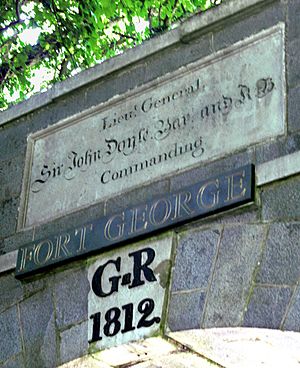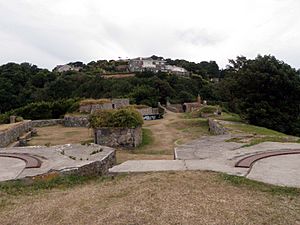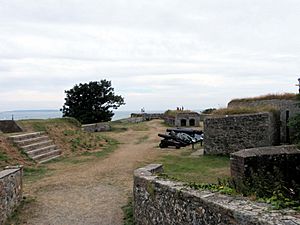Fort George, Guernsey facts for kids
Fort George is a big old fortress in Saint Peter Port, Guernsey. It was built a long time ago to be the main military base for the island. Its job was to protect the soldiers living there, taking over from an even older place called Castle Cornet.
Construction of Fort George began in 1780 and finished in 1812. It was planned during a time when Britain and France were often at war (the Anglo-French War (1778–83)). The fort was needed because more soldiers were sent to Guernsey. This was to stop France from trying to invade, like they did in Jersey in 1779 and 1781, which led to the Battle of Jersey.
Contents
The Story of Fort George
The land where Fort George stands used to be excellent fields for growing corn. But by 1775, during the American Revolutionary War, soldiers were already using the area. Sadly, an illness spread among the soldiers there in 1775-76, and it also affected people in nearby towns.
The old fort was in bad shape. General Charles Grey, 1st Earl Grey, who was in charge of Guernsey from 1797 to 1807, found it hard to convince the islanders to improve their defences. At one point, he even ordered part of the fort to be knocked down. He didn't want it to become a safe place for invaders. Luckily, it wasn't destroyed, and building work continued.
The fort was designed like a Star fort, which means it had a special shape with pointed parts. A separate small fort, Fort Irwin, was connected to it. Closer to the sea, the Clarence Battery was also built to help with defence.
In 1783, something unusual happened at Fort George. About 500 soldiers, mostly Irish, who were staying at the fort, started a mutiny. This means they rebelled against their officers. They wanted the fort gates to be left open so they could come and go freely. Even though this was agreed, the soldiers later fired at their officers, forcing them to leave the fort.
However, other soldiers from the 18th Regiment and the local Royal Guernsey Militia quickly surrounded the fort with cannons. After some shots were fired by the rebels, the militia outsmarted them, and the rebellious soldiers gave up. Thirty-six leaders of the mutiny were arrested. The island thanked the loyal soldiers and militia. The rebellious regiment was then moved away from Guernsey.
From 1794 to 1819, a special group of artillery soldiers was based at Fort George. Duels, which were fights between two people to settle an argument, were not allowed in Guernsey. But one famous duel happened near the fort in 1795. A Major Byng died after challenging a surgeon over a matter of respect for the National Anthem.
Before the barracks (soldiers' living quarters) were built at the fort, islanders had to provide homes for soldiers. Each town had to house a certain number of soldiers. If soldiers stayed in public houses or private homes, the town had to pay for it.
Lieutenant-General John Doyle became the commander of all forces in Guernsey in 1803. He declared a state of emergency in 1804 and worked hard to improve the island's defences. This included draining a marshy area called the Braye du Valle and building new forts and batteries along the coast. The building of Fort George sped up with Lt. Col. John Mackelcan leading the Royal Engineers. The fort was finally finished in 1812.
Families of soldiers usually lived in Saint Peter Port. In 1832, the famous artist J. M. W. Turner even sketched the fort. In 1853, a man who worked at the fort was the last person executed for murder in Guernsey. Also, some unwanted activities started happening near the fort. New laws were passed in 1895 and 1912 to try and control these problems.
Before World War I, the Royal Guernsey Light Infantry trained at Fort George. The first group of soldiers left the fort in 1917 to fight in France. A second group stayed at the fort to continue training new soldiers.
During World War II, German forces took over Fort George. They called it Stützpunkt Georgefest. They built several gun positions and a special radar station called "Adlerschloss." This station had large radar systems to warn them of Allied aircraft. Allied planes tried to destroy the radar station before the Normandy landings in June 1944, but they were not successful. Sometimes, unexploded bombs from those attacks are still found today.
The States of Guernsey (Guernsey's government) bought the land from the Crown in 1958. In 1967, most of the fort's buildings were knocked down. The land was sold to a company that built 120 luxury houses there. Many people in Guernsey were against this plan, with 21% of the population signing a petition, but the objections were not accepted.
What Makes Up Fort George?
The Main Entrance
The main way into Fort George is through a very impressive gateway. This gate still has its original wooden doors. Behind the gate, there would have been a moat (a ditch filled with water) and a drawbridge. These would have provided a second line of defence against attackers.
Above the gate, there is a plaque dedicated to Major-General Sir John Doyle. He was in charge of Guernsey from 1803 to 1816 and was the Commanding Officer of the fort in 1812.
What Protected the Fort?
In 1833, Fort George had many weapons. It had 34 cannons, one carronade (a type of short cannon), and four mortars (weapons that fire shells high into the air). Other strong batteries nearby also helped protect the fort. The armoury, where weapons were stored, held pikes, muskets, and swords.
Clarence Battery: A Key Defence Point
This battery was first built in 1780 and called Terres Point Battery. In 1815, it was renamed Clarence Battery to honour Prince William, Duke of Clarence, who later became King William IV. It had ten gun positions, allowing it to fire in two directions. There was also a magazine (for storing ammunition) and a Guard Room.
Later, the original guns were replaced with two powerful 5-inch guns. During the German occupation in World War II, they added anti-aircraft guns, machine guns, and a large searchlight.
The Fort's Cemetery
Fort George has a military cemetery. It is the final resting place for British soldiers and sailors from the 1800s and 1900s. It also holds the graves of 111 German soldiers and sailors. This cemetery is special because it contains war graves from both World Wars. The Commonwealth War Graves Commission keeps a list of all 136 military graves here, no matter their nationality.
Records of baptisms and burials from the fort between 1794 and 1810 are kept in the island archives. You can look at these records at the Priaulx Library.
Visiting Fort George Today
You can still visit parts of Fort George today, even though much of the land is now privately owned. Most of the smaller buildings were taken down, and what was left has been made into houses. The original main gate is still there and is used for cars to enter the estate. There are car parks at the bottom of the Belvedere field and near the cemetery.
From the Valette bathing places, you can walk to the aquarium. This aquarium is built inside a tunnel that goes under the fort! You can then climb steps up to the Clarence Battery. From there, you can get to the fort and the cemetery. (Note: In 2020, some steps were closed due to a landslide. You should use paths from the south or the bottom of Val Des Terres instead.)
The main road that goes from Saint Peter Port to the fort is called Le Val des Terres. It was opened in 1935 by Le Prince de Galles (the Prince of Wales). Before that, people used George Road to get to the fort.





